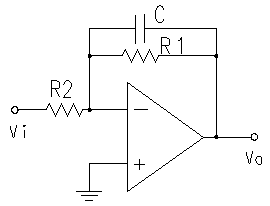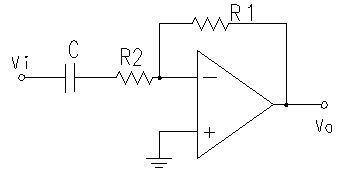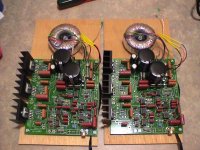I was "BoxSimming" and put some relatively cheap drivers in a random box. At first the response looked horrible but after five minutes of active filtering I found a reasonably flat response from 100 to 20 000 Hz. +-3 db. Will active filtering make cheap speakers sound great? And if so, why don't people do that?
Soldering together an active filter only takes about one afternoon, 20 dollars and multi-input amplifiers are all on ebay
Have I found some sort of Holy Grail or have I just disgraced the entire DIYaudio forum?
Soldering together an active filter only takes about one afternoon, 20 dollars and multi-input amplifiers are all on ebay
Have I found some sort of Holy Grail or have I just disgraced the entire DIYaudio forum?
An active crossover is not necessarily better than a passive one, and cheap speakers remain cheap speakers.
It is easier to achieve good results with active crossovers than with passive ones, because
Why doesn't everybody go active? One reason is that it takes more amplifiers, which are expensive and require more space. Another reason is that it takes much more calculation and less Trial-&-Error, which is what hobbies are about as opposed to professional working.
The most important reason of all is that big coils and caps are sexier than small caps and rectangular, black beetles (op amps).
It is easier to achieve good results with active crossovers than with passive ones, because
- - their reactions are more easily predictable. Their components do not interact with the complex speaker impedance.
- their components are much cheaper than for passive filters, which makes tweaking and correcting cheaper. That is why they are especially common with subwoofers, because big coils and big capacitors are just too expensive.
- you can do some things that are very difficult otherwise, e. g. equalizing, narrow notch filtering, boosting, continuous phase adjusting, etc.
Why doesn't everybody go active? One reason is that it takes more amplifiers, which are expensive and require more space. Another reason is that it takes much more calculation and less Trial-&-Error, which is what hobbies are about as opposed to professional working.
The most important reason of all is that big coils and caps are sexier than small caps and rectangular, black beetles (op amps).
Why doesn't everybody go active? One reason is that it takes more amplifiers, which are expensive and require more space.
It takes less heat sink, a smaller power transformer, and smaller capacitors to achieve a given SPL level with the active solution . The ouput devices can be the same just wired to more than one line level stage. It's that whole power dissipated is V^2/R thing - in a 2-way with equal sensitivity drivers 30V peak goes as far as 56V peak which subsequently gets divided into 30 and 26V peak signals. IOW, the amplifiers themselves can be smaller and less expensive for a given target SPL.
You can put the whole mess inside or beneath the speakers if you want like the Linkwitz Pluto. SL's boards are 7 or 8" on a side including XO and three power amps.
A photo of my Pluto boards with transformers is attached. They're cute little things.
Attachments
TheSeekerr said:Neither - unfortunately frequency response will never tell the whole story, you must consider also distortion, including harmonic, non-linear and phase distortion. Cheap drivers tend to have plenty of the first two, and active filters can have problems with the third.
Active analog filters can have identical phase response to passive ones, and if you want you can electronically delay drivers to aim the main output lobe from the cross-over without physically moving the drivers.
IIR digital filters are the same.
The OP is correct, EQ can make cheap drivers sounds well. Yes it will have higher distortion, but this does not make it necessarily sound bad. Frequency response is still the most important factor to how a speaker sounds. Try it out for yourselves and you'd be surprised. Theorycrafting only gets us so far.
However, some cheap drivers have a lot of mechanical noise at high output. So you can't have everything. And it's not that expensive drivers are immune to this, the scanspeak revelator woofers have quite a bit of mechanical noise itself, at higher output.
However, some cheap drivers have a lot of mechanical noise at high output. So you can't have everything. And it's not that expensive drivers are immune to this, the scanspeak revelator woofers have quite a bit of mechanical noise itself, at higher output.
infinia said:How do you define boxsimming?
Box modeling programs are only good around the LF cutoff region.
Untill you start measuring things with microphones then your perfect world will be "rocked" again.
This is the software BoxSim and I realised that using random cheap Visaton drivers in a random case doesn't make it a bad speaker after using some very basic low and high cutoff filters.
That would make a 8-year-old able to build speakers. There must be some disadvantage except from using very cheap drivers with lots of distortion?!
The ultimate DIY solution would be using modules of these little circuits with a pot:


And just use it for trial-and-error. "Too much bass. Turn the lowpass frequency lower or put another module behind the first to make the slope steeper." The same for the High frequency drivers. Too loud, change the gain on the final opamp.
Again, this is just thinking out loud. Please tell me what I am doing wrong/right!
Hi,
the answer to Your Q is: "It depends!"
Putting some cheap driver (remark: cheap doesn´t necessarily imply bad) in a random cabinet won´t result in a good result in the vast majority of cases. No equing and filtering will make a good speaker out of such a construction in any way. Wonders and miracles are other peoples business
So lets assume that You did your homework and used drives of reasonable quakity in a reasonably fitting cabinet.
Even than active filtering isn´t necessarily superior.
Every good passive filter design includes some equalizing. Modern simulators are quite exact, so that basically everybody who is able to switch on the PC can get a fairly good result.
When You are not familiar with active filter design, nor You don´t realize which end of the soldering iron is the hot end...You could only use standard off-the-shelf active filter modules/crossovers. But those just filter..they miss out on the equing functions. The result will be much worse than a good passive filter. Too many have gone this way and this is probabely one of the major reasons that active filtering still has a bad reputation.
If done properly active filtering offers some serious advantages which can lead (imo) to a better sound device.
jauu
Calvin
ps. The pic doesn´t show a typical Lowpass, but rather a basslift (LP with gain) and no, this little circuit doesn´t qualify for the label ´ultimate´
That this here isn´t true:
the answer to Your Q is: "It depends!"
Putting some cheap driver (remark: cheap doesn´t necessarily imply bad) in a random cabinet won´t result in a good result in the vast majority of cases. No equing and filtering will make a good speaker out of such a construction in any way. Wonders and miracles are other peoples business
So lets assume that You did your homework and used drives of reasonable quakity in a reasonably fitting cabinet.
Even than active filtering isn´t necessarily superior.
Every good passive filter design includes some equalizing. Modern simulators are quite exact, so that basically everybody who is able to switch on the PC can get a fairly good result.
When You are not familiar with active filter design, nor You don´t realize which end of the soldering iron is the hot end...You could only use standard off-the-shelf active filter modules/crossovers. But those just filter..they miss out on the equing functions. The result will be much worse than a good passive filter. Too many have gone this way and this is probabely one of the major reasons that active filtering still has a bad reputation.
If done properly active filtering offers some serious advantages which can lead (imo) to a better sound device.
jauu
Calvin
ps. The pic doesn´t show a typical Lowpass, but rather a basslift (LP with gain) and no, this little circuit doesn´t qualify for the label ´ultimate´
That this here isn´t true:
is simply proofed by the fact that there are so many mediocre speakers around and just so very very very few very good ones.That would make a 8-year-old able to build speakers
8-year-olds could do many things that are commonly perceived as difficult, given the right tools and a short training.robertvalk said:That would make a 8-year-old able to build speakers.
Is DIY not about finding things like that out by trying them? Don't forget to post the results.robertvalk said:There must be some disadvantage except from using very cheap drivers with lots of distortion
I once applied a set of active filters to a full range driver (Monacor SPH-30X) and the improvement was very apparent. The filters dealt with cone breakup and other frequency anomalies as well as baffle step plus bass response 
As pointed out, many speakers implement at least some filtering, either active or passive. BSC being the most obvious but with a hard coned driver in particular a notch filter should be applied to help control the peak.
As pointed out, many speakers implement at least some filtering, either active or passive. BSC being the most obvious but with a hard coned driver in particular a notch filter should be applied to help control the peak.
My short answer is No.
Although active eq can make somethings better than with other solutions, but it not the means to perfection in itself. There are so many things that cannot be corrected for, once a driver is chosen. A system is only as strong as its weakest link. In otherwords, pick your drivers wisely in the initial design phase.
Although active eq can make somethings better than with other solutions, but it not the means to perfection in itself. There are so many things that cannot be corrected for, once a driver is chosen. A system is only as strong as its weakest link. In otherwords, pick your drivers wisely in the initial design phase.
BoxSim has a good rep to be very accurate, because they implement real world measurements of the Visaton drivers and maybe because of the software itself.the software BoxSim
Regards
gedlee said:If you look at total system costs, active will seldom stack up to a passive system. Active is easier to implement, but in the end is no better than passive, it just costs more.
Certainly an active system gets expensive in a hurry, especially 3+ way designs. Look at the amplifier cost for the Orion as an example.
BUT, if you are a serial builder who reuses the amps and crossover case & PSU (assuming DIY) successive projects can be much less expensive when active. A wide variety of small film caps and resistors is less expensive than keeping a good selection of passive XO parts.
I like building amps, so I have plenty available. Some follow the Linkwitz example and are built on slabs of MDF, some are presentable. The point is for me a new XO costs $20 or so. I cannot think of many passive crossovers that can be built for that much.
The other side is design time and cost. For many of us not in the business a good design package is a bit too expensive to justify. With free electronic circuit simulators and Speaker workshop I can settle in on a pretty good approximation of the required transfer functions pretty quickly then build, measure, tweak, repeat as required. A little eq here or there is easy to incorporate without causing changes throughout the system.
YMMV, as always.
gedlee said:If you look at total system costs, active will seldom stack up to a passive system. Active is easier to impliment, but in the end is no better than passive, it just costs more.
It doesn't cost more if you do everything DIY.
Active filter can cost less/more or the same as passive filer.
You need 2x amps. But considering the same sensitivity for LF and HF
drivers, if you use 2x25W amps you can get about the same SPL as with
100W amp. This will allow use of smaller Transformer, Filtering caps and smaller radiators.
If there is difference between SPL ratings of drivers than you can use different power amps, and not waste power into resistors.
I'm going to jump in here with a totally biased opinion.
In most cases that I have come across a cheap driver crossed actively will sound better than passive BUT in a lot of cases it will depend on the drivers themselves.
Some cheap drivers sold as woofers are excellent mid-ranges if the low frequencies can be removed so that they are not acting in their pistonic range. This cross-over frequency can sometimes be very low 90->> 120 Hz, in this case it makes economic sense as well as SQ sense to use active filters.
Make the assumption that you already have the ability to split the signal at the pre-amp stage and use the cheapest dirtiest amp for the low bass here we are less sensitive to the distortion.
Passive filters make sense for HF where the cost of components is reasonable.
In most cases that I have come across a cheap driver crossed actively will sound better than passive BUT in a lot of cases it will depend on the drivers themselves.
Some cheap drivers sold as woofers are excellent mid-ranges if the low frequencies can be removed so that they are not acting in their pistonic range. This cross-over frequency can sometimes be very low 90->> 120 Hz, in this case it makes economic sense as well as SQ sense to use active filters.
Make the assumption that you already have the ability to split the signal at the pre-amp stage and use the cheapest dirtiest amp for the low bass here we are less sensitive to the distortion.
Passive filters make sense for HF where the cost of components is reasonable.
tpsorin said:
It doesn't cost more if you do everything DIY.
You're not comparing apples to apples. Wind your own inductors and caps and its still cheaper with passive.
- Status
- This old topic is closed. If you want to reopen this topic, contact a moderator using the "Report Post" button.
- Home
- Loudspeakers
- Multi-Way
- Will active crossovers make cheap drivers sound well?
